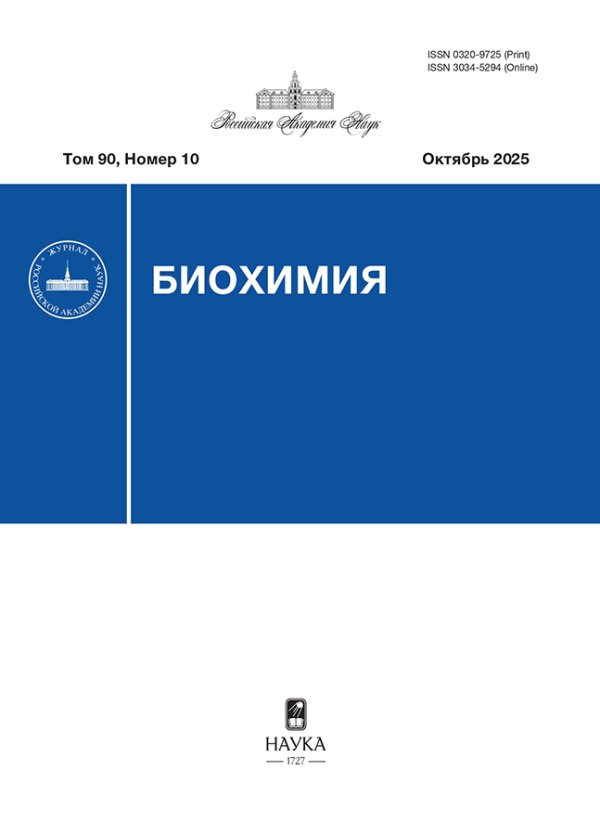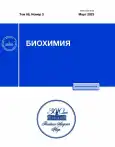Alterations in the properties of the glutamatergic system of the rat hippocampus in a lithium-pilocarpine model of temporal lobe epilepsy
- Authors: Diespirov G.P1, Postnikova T.Y1, Griflyuk A.V1, Kovalenko A.A1, Zaitsev A.V1
-
Affiliations:
- Sechenov Institute of Evolutionary Physiology and Biochemistry, Russian Academy of Sciences
- Issue: Vol 88, No 3 (2023)
- Pages: 429-442
- Section: Articles
- URL: https://journals.rcsi.science/0320-9725/article/view/144651
- DOI: https://doi.org/10.31857/S0320972523030053
- EDN: https://elibrary.ru/QWLEGQ
- ID: 144651
Cite item
Full Text
Abstract
About the authors
G. P Diespirov
Sechenov Institute of Evolutionary Physiology and Biochemistry, Russian Academy of Sciences
Email: aleksey_zaitsev@mail.ru
194223 St. Petersburg, Russia
T. Y Postnikova
Sechenov Institute of Evolutionary Physiology and Biochemistry, Russian Academy of Sciences
Email: aleksey_zaitsev@mail.ru
194223 St. Petersburg, Russia
A. V Griflyuk
Sechenov Institute of Evolutionary Physiology and Biochemistry, Russian Academy of Sciences
Email: aleksey_zaitsev@mail.ru
194223 St. Petersburg, Russia
A. A Kovalenko
Sechenov Institute of Evolutionary Physiology and Biochemistry, Russian Academy of Sciences
Email: aleksey_zaitsev@mail.ru
194223 St. Petersburg, Russia
A. V Zaitsev
Sechenov Institute of Evolutionary Physiology and Biochemistry, Russian Academy of Sciences
Email: aleksey_zaitsev@mail.ru
194223 St. Petersburg, Russia
References
- Fattorusso, A., Matricardi, S., Mencaroni, E., Dell'Isola, G. B., Di Cara, G., Striano, P., and Verrotti, A. (2021) The pharmacoresistant epilepsy: an overview on existant and new emerging therapies, Front. Neurol., 12, 1030, doi: 10.3389/FNEUR.2021.674483.
- Chin, J. H., and Vora, N. (2014) The global burden of neurologic diseases, J. Neurol., 83, 349-351, doi: 10.1212/WNL.0000000000000610.
- Fordington, S., and Manford, M. (2020) A review of seizures and epilepsy following traumatic brain injury, J. Neurol., 267, 3105-3111, doi: 10.1007/s00415-020-09926-w.
- Engel, J. J. (2001) Mesial temporal lobe epilepsy: what have we learned? Neuroscientist, 7, 340-352, doi: 10.1177/107385840100700410.
- Herman, S. T. (2002) Epilepsy after brain insult: targeting epileptogenesis, J. Neurol., 59, S21-S26, doi: 10.1212/wnl.59.9_suppl_5.s21.
- Pitk�nen, A., and Lukasiuk, K. (2011) Mechanisms of epileptogenesis and potential treatment targets, Lancet Neurol., 10, 173-186, doi: 10.1016/S1474-4422(10)70310-0.
- Goldberg, E. M., and Coulter, D. A. (2013) Mechanisms of epileptogenesis: a convergence on neural circuit dysfunction, Nat. Rev. Neurosci., 14, 337-349, doi: 10.1038/nrn3482.
- Thom, M. (2014) Review: hippocampal sclerosis in epilepsy: a neuropathology review, Neuropathol. Appl. Neurobiol., 40, 520-543, doi: 10.1111/nan.12150.
- Bliss, T. V. P., and Collingridge, G. L. (1993) A synaptic model of memory: long-term potentiation in the hippocampus, Nature, 361, 31-39, doi: 10.1038/361031a0.
- Titiz, A. S., Mahoney, J. M., Testorf, M. E., Holmes, G. L., and Scott, R. C. (2014) Cognitive impairment in temporal lobe epilepsy: role of online and offline processing of single cell information, Hippocampus, 24, 1129-1145, doi: 10.1002/hipo.22297.
- Vlooswijk, M. C. G., Jansen, J. F. A., de Krom, M. C. F. T. M., Majoie, H. M., Hofman, P. A. M., Backes, W. H., and Aldenkamp, A. P. (2010) Functional MRI in chronic epilepsy: associations with cognitive impairment, Lancet Neurol., 9, 1018-1027, doi: 10.1016/S1474-4422(10)70180-0.
- Zavala-Tecuapetla, C., Cuellar-Herrera, M., and Luna-Munguia, H. (2020) Insights into potential targets for therapeutic intervention in epilepsy, Int. J. Mol. Sci., 21, 8573, doi: 10.3390/ijms21228573.
- Curia, G., Longo, D., Biagini, G., Jones, R. S. G., and Avoli, M. (2008) The pilocarpine model of temporal lobe epilepsy, J. Neurosci. Methods, 172, 143-157, doi: 10.1016/j.jneumeth.2008.04.019.
- Curia, G., Lucchi, C., Vinet, J., Gualtieri, F., Marinelli, C., Torsello, A., Costantino, L., and Biagini, G. (2014) Pathophysiogenesis of mesial temporal lobe epilepsy: is prevention of damage antiepileptogenic? Curr. Med. Chem., 21, 663-688, doi: 10.2174/0929867320666131119152201.
- Zaitsev, A. V., Amakhin, D. V., Dyomina, A. V., Zakharova, M. V., Ergina, J. L., Postnikova, T. Y., Diespirov, G. P., and Magazanik, L. G. (2021) Synaptic dysfunction in epilepsy, J. Evol. Biochem. Physiol., 57, 542-563, doi: 10.1134/S002209302103008X.
- De Oliveira, D. L., Fischer, A., Jorge, R. S., Da Silva, M. C., Leite, M., Gon�alves, C. A., Quillfeldt, J. A., Souza, D. O., E Souza, T. M., and Wofchuk, S. (2008) Effects of early-life LiCl-Pilocarpine-induced status epilepticus on memory and anxiety in adult rats are associated with mossy fiber sprouting and elevated CSF S100B protein, Epilepsia, 49, 842-852, doi: 10.1111/j.1528-1167.2007.01484.x.
- Morimoto, K., Fahnestock, M., and Racine, R. J. (2004) Kindling and status epilepticus models of epilepsy: rewiring the brain, Prog. Neurobiol., 73, 1-60, doi: 10.1016/j.pneurobio.2004.03.009.
- Postnikova, T. Y., Diespirov, G. P., Amakhin, D. V., Vylekzhanina, E. N., Soboleva, E. B., and Zaitsev, A. V. (2021) Impairments of long-term synaptic plasticity in the hippocampus of young rats during the latent phase of the lithium-pilocarpine model of temporal lobe epilepsy, Int. J. Mol. Sci., 22, 13355, doi: 10.3390/ijms222413355.
- Plata, A., Lebedeva, A., Denisov, P., Nosova, O., Postnikova, T. Y., Pimashkin, A., Brazhe, A., Zaitsev, A. V., Rusakov, D. A., and Semyanov, A. (2018) Astrocytic atrophy following status epilepticus parallels reduced Ca2+ activity and impaired synaptic plasticity in the rat hippocampus, Front. Mol. Neurosci., 11, 215, doi: 10.3389/fnmol.2018.00215.
- Kryukov, K. A., Kim, K. K., Magazanik, L. G., and Zaitsev, A. V. (2016) Status epilepticus alters hippocampal long-term synaptic potentiation in a rat lithium-pilocarpine model, NeuroReport, 27, 1191-1195, doi: 10.1097/WNR.0000000000000656.
- Clarkson, C., Smeal, R. M., Hasenoehrl, M. G., White, J. A., Rubio, M. E., and Wilcox, K. S. (2020) Ultrastructural and functional changes at the tripartite synapse during epileptogenesis in a model of temporal lobe epilepsy, Exp. Neurol., 326, 113196, doi: 10.1016/j.expneurol.2020.113196.
- Naylor, D. E., Liu, H., Niquet, J., and Wasterlain, C. G. (2013) Rapid surface accumulation of NMDA receptors increases glutamatergic excitation during status epilepticus, Neurobiol. Dis., 54, 225-238, doi: 10.1016/j.nbd.2012.12.015.
- Amakhin, D. V., Soboleva, E. B., Ergina, J. L., Malkin, S. L., Chizhov, A. V., and Zaitsev, A. V. (2018) Seizure-induced potentiation of AMPA receptor-mediated synaptic transmission in the entorhinal cortex, Front. Cell. Neurosci., 12, 486, doi: 10.3389/fncel.2018.00486.
- Rajasekaran, K., Todorovic, M., and Kapur, J. (2012) Calcium-permeable AMPA receptors are expressed in a rodent model of status epilepticus, Ann. Neurol., 72, 91-102, doi: 10.1002/ana.23570.
- Amakhin, D. V., Malkin, S. L., Ergina, J. L., Kryukov, K. A., Veniaminova, E. A., Zubareva, O. E., and Zaitsev, A. V. (2017) Alterations in properties of glutamatergic transmission in the temporal cortex and hippocampus following pilocarpine-induced acute seizures in wistar rats, Front. Cell. Neurosci., 11, 264, doi: 10.3389/fncel.2017.00264.
- Malkin, S. L., Amakhin, D. V., Veniaminova, E. A., Kim, K. K., Zubareva, O. E., Magazanik, L. G., and Zaitsev, A. V. (2016) Changes of AMPA receptor properties in the neocortex and hippocampus following pilocarpine-induced status epilepticus in rats, Neuroscience, 327, 146-155, doi: 10.1016/j.neuroscience.2016.04.024.
- Zubareva, O. E., Kovalenko, A. A., Kalemenev, S. V., Schwarz, A. P., Karyakin, V. B., and Zaitsev, A. V. (2018) Alterations in mRNA expression of glutamate receptor subunits and excitatory amino acid transporters following pilocarpine-induced seizures in rats, Neurosci. Lett., 686, 94-100, doi: 10.1016/j.neulet.2018.08.047.
- Racine, R. J. (1972) Modification of seizure activity by electrical stimulation. II. Motor seizure, Electroencephalogr. Clin. Neurophysiol., 32, 281-294, doi: 10.1016/0013-4694(72)90177-0.
- Postnikova, T. Y., Amakhin, D. V., Trofimova, A. M., Smolensky, I. V., and Zaitsev, A. V. (2019) Changes in functional properties of rat hippocampal neurons following pentylenetetrazole-induced status epilepticus, Neuroscience, 399, 103-116, doi: 10.1016/j.neuroscience.2018.12.029.
- Schwarz, A. P., Malygina, D. A., Kovalenko, A. A., Trofimov, A. N., and Zaitsev, A. V. (2020) Multiplex qPCR assay for assessment of reference gene expression stability in rat tissues/samples, Mol. Cell. Probes, 53, 101611, doi: 10.1016/j.mcp.2020.101611.
- Livak, K. J., and Schmittgen, T. D. (2001) Analysis of relative gene expression data using real-time quantitative PCR and the 2(-Delta Delta C(T)) method, Methods, 25, 402-428, doi: 10.1006/meth.2001.1262.
- Bonefeld, B. E., Elfving, B., and Wegener, G. (2008) Reference genes for normalization: a study of rat brain tissue, Synapse, 62, 302-309, doi: 10.1002/syn.20496.
- Lin, W., Burks, C. A., Hansen, D. R., Kinnamon, S. C., and Gilbertson, T. A. (2004) Taste receptor cells express pH-sensitive leak K+ channels, J. Neurophysiol., 92, 2909-2919, doi: 10.1152/jn.01198.2003.
- Yamaguchi, M., Yamauchi, A., Nishimura, M., Ueda, N., and Naito, S. (2005) Soybean oil fat emulsion prevents cytochrome P450 mRNA down-regulation induced by fat-free overdose total parenteral nutrition in infant rats, Biol. Pharm. Bull., 28, 143-147, doi: 10.1248/bpb.28.143.
- Swijsen, A., Nelissen, K., Janssen, D., Rigo, J. M., and Hoogland, G. (2012) Validation of reference genes for quantitative real-time PCR studies in the dentate gyrus after experimental febrile seizures, BMC Res. Notes, 5, 685, doi: 10.1186/1756-0500-5-685.
- Pohjanvirta, R., Niittynen, M., Lind�n, J., Boutros, P. C., Moffat, I. D., and Okey, A. B. (2006) Evaluation of various housekeeping genes for their applicability for normalization of mRNA expression in dioxin-treated rats, Chem. Biol. Interact., 160, 134-149, doi: 10.1016/j.cbi.2006.01.001.
- Cook, N. L., Vink, R., Donkin, J. J., and van den Heuvel, C. (2009) Validation of reference genes for normalization of real-time quantitative RT-PCR data in traumatic brain injury, J. Neurosci. Res., 87, 34-41, doi: 10.1002/jnr.21846.
- Langnaese, K., John, R., Schweizer, H., Ebmeyer, U., and Keilhoff, G. (2008) Selection of reference genes for quantitative real-time PCR in a rat asphyxial cardiac arrest model, BMC Mol. Biol., 9, 53, doi: 10.1186/1471-2199-9-53.
- Proudnikov, D., Yuferov, V., Zhou, Y., LaForge, K. S., Ho, A., and Kreek, M. J. (2003) Optimizing primer-probe design for fluorescent PCR, J. Neurosci. Methods, 123, 31-45, doi: 10.1016/S0165-0270(02)00325-4.
- Zucker, R. S., and Regehr, W. G. (2002) Short-term synaptic plasticity, Annu. Rev. Physiol., 64, 355-405, doi: 10.1146/annurev.physiol.64.092501.114547.
- Owen, B., Bichler, E., and Benveniste, M. (2021) Excitatory synaptic transmission in hippocampal area CA1 is enhanced then reduced as chronic epilepsy progresses, Neurobiol. Dis., 154, 105343, doi: 10.1016/j.nbd.2021.105343.
- Cull-Candy, S. G., and Farrant, M. (2021) Ca2+-permeable AMPA receptors and their auxiliary subunits in synaptic plasticity and disease, J. Physiol., 599, 2655-2671, doi: 10.1113/jp279029.
- Andre, V., Marescaux, C., Nehlig, A., and Fritschy, J. M. (2001) Alterations of hippocampal GABAergic system contribute to development of spontaneous recurrent seizures in the at lithium-pilocarpine model of temporal lobe epilepsy, Hippocampus, 11, 452-468, doi: 10.1002/hipo.1060.
Supplementary files










